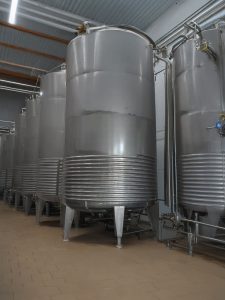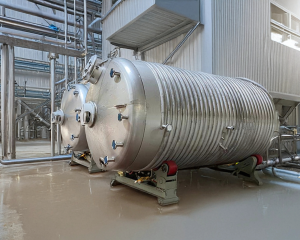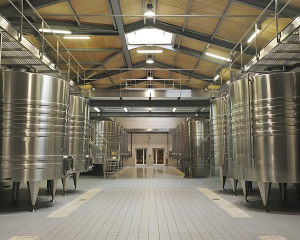Serpantinli Tank
- Home
- Serpantinli Tank
1. Serpantinli Tank Nedir?
Serpantinli tank, içerisinde sıvıların ısıtılması veya soğutulması amacıyla kullanılan özel tasarıma sahip bir tank türüdür. İç kısmında bulunan serpantin boru sistemi, ısı transferini sağlar. Genellikle suyun ısıtılması veya sıcak suyun depolanması amacıyla tercih edilir.
Temel Özellikleri:
- Serpantin Sistemi: İçerisinde dolanan borular sayesinde su veya diğer sıvılar etkin bir şekilde ısıtılır.
- Yalıtım: Isı kaybını önlemek için özel yalıtım malzemeleri kullanılır.
- Dayanıklılık: Paslanmaz çelik veya emaye kaplama gibi uzun ömürlü malzemelerle üretilir.
Kullanım Amaçları:
- Sıcak su temini
- Güneş enerjisi sistemlerinde enerji depolama
- Endüstriyel proseslerde ısı transferi
- Isıtma ve soğutma sistemlerinde ara depo

2. Serpantinli Tankların Çalışma Prensibi
Serpantinli depolama tankları, ısı değişimi prensibine göre çalışır. Tankın içindeki serpantin borulardan geçen ısıtıcı akışkan, çevresindeki suya veya başka bir sıvıya ısı enerjisini aktarır. Bu süreçte hem enerji tasarrufu sağlanır hem de istenilen sıcaklıkta sıvı elde edilir.
Isı Transfer Mekanizması:
- Serpantin boru hattı içinden sıcak su veya buhar geçirilir.
- Isı, boruların yüzeyinden tanka aktarılır.
- Tankın içindeki sıvı, hedef sıcaklığa ulaşıncaya kadar ısıtılır.
Serpantin Yapısının Rolü:
- Yüksek ısı iletim yüzeyi sağlar.
- Isının homojen şekilde dağılmasını garantiler.
- Enerji kaybını minimize eder.
Enerji Verimliliği:
- Isı transfer verimliliği %90’ın üzerindedir.
- Doğru serpantin boyutlandırması ve izolasyon, maksimum enerji tasarrufu sağlar.

3. Serpantinli Tank Türleri
Farklı kullanım amaçlarına göre çeşitli serpantinli depolama tankları mevcuttur. Seçim yaparken sistemin ihtiyaçlarını göz önünde bulundurmak önemlidir.
Tek Serpantinli Tanklar:
- Genellikle küçük ölçekli sistemlerde kullanılır.
- Sadece bir ısıtıcı kaynakla çalışır (ör. güneş enerjisi veya kazan).
Çift Serpantinli Tanklar:
- İki ayrı ısı kaynağı bağlanabilir.
- Örneğin, hem güneş enerjisi hem de kombi sistemi entegre edilebilir.
Paslanmaz Çelik Serpantinli Tanklar:
- Korozyona dayanıklıdır.
- Gıda endüstrisi gibi hijyenin önemli olduğu alanlarda kullanılır.
Emaye Kaplamalı Serpantinli Tanklar:
- Kireç ve pas oluşumunu önler.
- Uzun ömürlü kullanım sağlar.

4. Serpantinli Tank Malzemeleri
Tankın dayanıklılığı ve verimliliği kullanılan malzemelere bağlıdır. Kaliteli malzeme, hem uzun ömür hem de güvenli kullanım sağlar.
- Paslanmaz Çelik: Korozyon direnci yüksektir. Gıda ve içme suyu uygulamalarında idealdir.
- Karbon Çelik: Maliyet açısından daha uygun. Endüstriyel uygulamalarda yaygındır.
- Polietilen ve Diğer Kompozitler: Hafif ve taşınabilir. Kimyasallara dayanıklıdır.
- Emaye Kaplama Avantajları: İç yüzeyi korur. Kireç birikimini ve paslanmayı önler.
5. Serpantinli Tankın Avantajları
Serpantinli tanklar, sağladığı çeşitli avantajlar sayesinde birçok sektörde tercih edilir.
- Yüksek Isı Verimliliği: Serpantin sistemi, etkili ısı transferi sağlar.
- Enerji Tasarrufu: İyi yalıtım ve verimli ısıtma sayesinde enerji kaybı minimize edilir.
- Uzun Ömürlü Kullanım: Kaliteli malzemelerle üretildiğinde 20 yıla kadar dayanabilir.
- Düşük Bakım Maliyeti: Düzenli temizlikle uzun süre sorunsuz çalışır.
- Çok Yönlülük: Çeşitli enerji kaynaklarıyla uyumludur (güneş enerjisi, kazan, ısı pompası vb.).
6. Serpantinli Tankın Dezavantajları
Her ne kadar avantajları fazla olsa da bazı dezavantajları da göz önünde bulundurulmalıdır.
- İlk Yatırım Maliyeti: Kaliteli malzemeden üretilen tanklar yüksek maliyetli olabilir.
- Düzenli Bakım Gerekliliği: Performans kaybını önlemek için periyodik temizlik şarttır.
- Alan Gereksinimi: Büyük kapasiteli tanklar geniş alanlara ihtiyaç duyar.
7. Kullanım Alanları
Serpantinli tanklar farklı sektörlerde geniş bir kullanım alanına sahiptir.
- Güneş Enerjisi Sistemleri: Güneş panellerinden gelen ısıyı depolamak için kullanılır.
- Isıtma ve Soğutma Sistemleri: Konutlarda ve endüstriyel alanlarda yaygın olarak tercih edilir.
- Endüstriyel Uygulamalar: Kimyasal proseslerde sıcaklık kontrolü sağlar.
- Sıcak Su Depolama Sistemleri: Evsel kullanım için sıcak su depolamakta idealdir.
8. Serpantinli Tank Tasarımı
Verimli bir serpantinli tank için dikkat edilmesi gereken bazı tasarım kriterleri vardır.
- Hacim Hesaplamaları: Kullanım ihtiyacına göre doğru hacim belirlenmelidir. Ev kullanımı için genelde 200-500 litre kapasiteli tanklar yeterlidir.
- Serpantin Boyutlandırması: Isı kaynağına ve sıvının türüne göre serpantin çapı ve uzunluğu hesaplanmalıdır.
- Yalıtım Seçenekleri: Poliüretan köpük veya cam yünü gibi yalıtım malzemeleri tercih edilmelidir. Kaliteli yalıtım %30’a varan enerji tasarrufu sağlar.
- Güvenlik Önlemleri: Aşırı ısınmaya karşı emniyet ventilleri kullanılmalıdır. Basınç kontrol sistemleri gereklidir.
9. Serpantinli Tank Montajı ve Kurulumu
Montaj sırasında dikkat edilmesi gereken bazı önemli noktalar vardır.
Kurulum Adımları:
- Tankın yerleştirileceği alanın belirlenmesi.
- Bağlantı borularının monte edilmesi.
- Isı kaynağına entegrasyonun sağlanması.
- Test işlemlerinin yapılması.
Dikkat Edilmesi Gerekenler:
- Tankın düzgün bir zemine yerleştirilmesi.
- Isı ve basınç dayanımı kontrol edilmelidir.
- Profesyonel yardım alınması önerilir.
10. Serpantinli Tank Bakımı
Performansın korunması ve tankın ömrünün uzatılması için düzenli bakım şarttır.
Düzenli Temizlik Prosedürleri:
- Yılda en az bir kez iç yüzeyin temizlenmesi gerekir.
- Serpantin boruları kireçten arındırılmalıdır.
Kireçlenme Önlemleri:
- Su yumuşatma sistemleri kullanılabilir.
- Kimyasal çözücülerle düzenli bakım yapılmalıdır.
Sızdırmazlık Kontrolleri:
- Tüm bağlantı noktaları düzenli olarak kontrol edilmelidir.
- Gerekli durumlarda contalar değiştirilmelidir.
11. Enerji Verimliliği ve Performans Artırma Yöntemleri
Serpantinli tankların performansını artırmak için bazı stratejiler kullanılabilir.
- Isı Kaybını Azaltma: Yüksek kaliteli yalıtım tercih edilmelidir.
- Verimli Serpantin Kullanımı: Yüksek ısı transfer katsayısına sahip malzemeler tercih edilmelidir.
- Otomatik Kontrol Sistemleri: Sıcaklık ve basınç izleme sistemleriyle verim artırılabilir.
12. Serpantinli Depolama Tankı Seçim Kriterleri
Doğru tank seçimi için aşağıdaki kriterlere dikkat edilmelidir:
- Kapasite: Kullanım ihtiyacına göre uygun hacim belirlenmelidir.
- Malzeme Kalitesi: Uzun ömürlü ve dayanıklı malzemeler tercih edilmelidir.
- Entegrasyon: Mevcut sistemlerle uyumlu olmasına dikkat edilmelidir.
- Bütçe: Hem kalite hem de maliyet dengesi gözetilmelidir.
13. Serpantinli Tank Fiyatları (2024)
Serpantinli tanklarının fiyatları birçok faktöre göre değişiklik gösterir.
- Malzeme Bazlı Fiyatlandırma: Paslanmaz çelik tanklar daha pahalı ancak dayanıklıdır. Karbon çelik ve emaye kaplama daha uygun fiyatlı alternatiflerdir.
- Marka ve Model Karşılaştırmaları: Piyasadaki en iyi modelleri ve fiyatlarını karşılaştırmak faydalı olur.
- Kurulum ve Nakliye Maliyetleri: Tankın hacmine göre nakliye ve kurulum maliyetleri değişir.
14. Serpantinli Tank Satın Alma Rehberi
Doğru seçim yapmak için aşağıdaki adımları izleyebilirsiniz:
- Güvenilir üreticilerden satın alın.
- Garanti süresi ve sertifikalar kontrol edilmeli.
- Müşteri yorumları ve uzman incelemeleri dikkate alınmalı.
Serpantinli tanklar, enerji verimliliği ve uzun ömürlü yapılarıyla hem evsel hem de endüstriyel kullanımlar için mükemmel bir seçenektir. Doğru tankı seçerek hem enerji tasarrufu yapabilir hem de sistem verimliliğinizi artırabilirsiniz.
15. Sıkça Sorulan Sorular (SSS)
Tek serpantinli mi çift serpantinli mi tercih etmeliyim?
Eğer sadece tek bir ısı kaynağınız varsa (örneğin sadece güneş enerjisi veya sadece katı yakıtlı kazan), tek serpantinli tank yeterlidir. Ancak hem güneş enerjisi hem de kombi/ısı pompası gibi iki farklı kaynağı aynı anda sisteme entegre etmek istiyorsanız çift serpantinli tank kullanmalısınız.
Serpantinli tankta kireçlenme nasıl önlenir?
Şebeke suyunun sertliğine bağlı olarak kireçlenme olabilir. Bunu önlemek için tank girişine su yumuşatma cihazı takılabilir veya belirli periyotlarla yetkili servis tarafından kimyasal temizlik yapılmalıdır. Emaye kaplı tanklar kirece karşı daha dirençlidir.
Serpantinli boyler ile serpantinli akümülasyon tankı arasındaki fark nedir?
Boylerler genellikle içindeki suyu ısıtıp doğrudan kullanım sıcak suyu (musluk suyu) olarak sunmak için tasarlanmıştır ve iç yüzeyleri hijyeniktir (emaye veya paslanmaz). Akümülasyon tankları ise genellikle ısıtma sisteminin suyunu depolamak (ısıyı hapsetmek) için kullanılır ve içindeki su tesisatta dolaşır.

